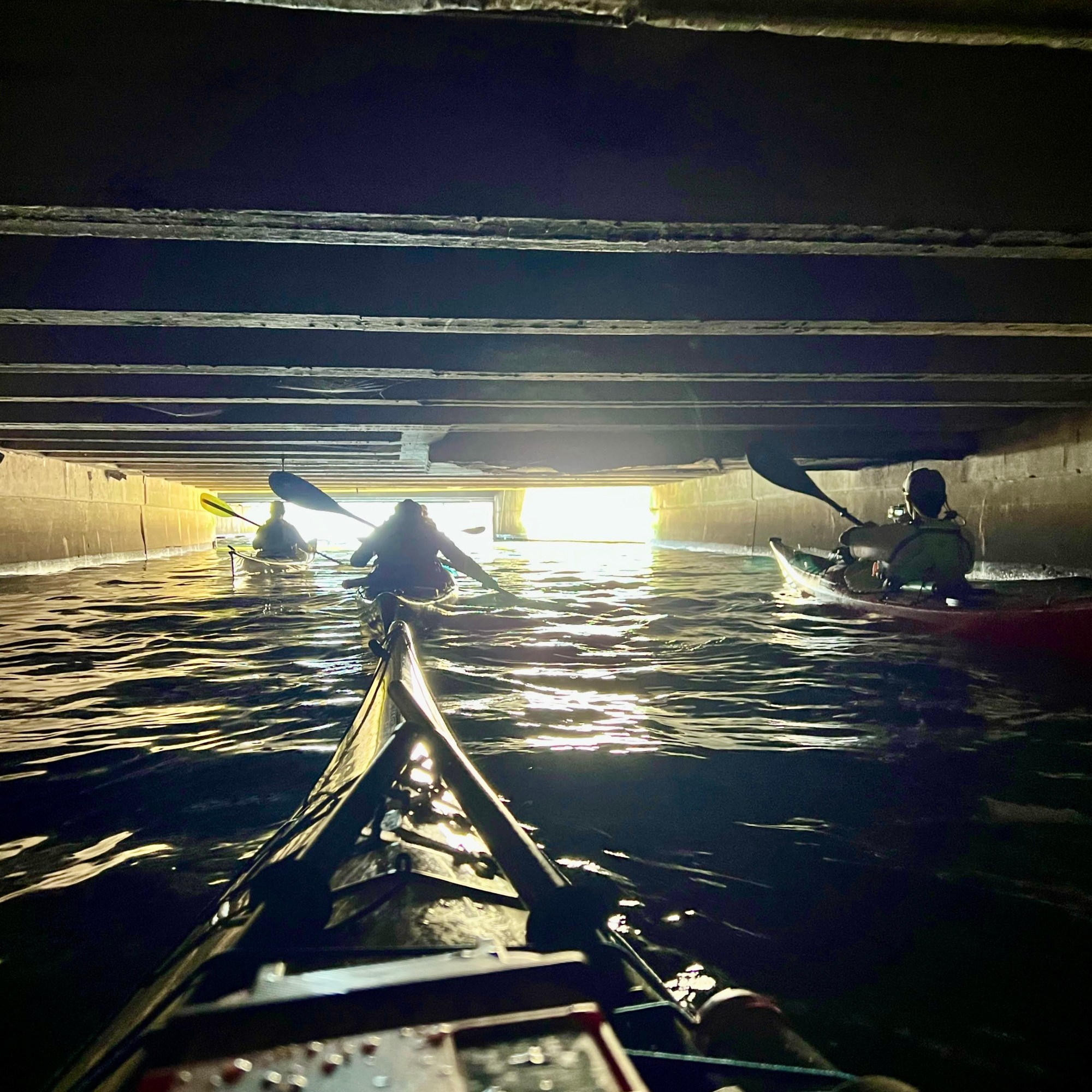How to Lead Your Own Trip

A Guide for Group Leaders, Guides, and Self-Guided Paddlers
If you’re leading others (or simply taking responsibility for yourself) on a kayaking trip that goes beyond the protected shore, be thoroughly prepped. You’re navigating tides, wind, distance, emotions, and real risk. This guide outlines how to plan and execute on successful outings in open water. Disclaimer: we can’t cover everything here, but some is better than none!
Prepare Yourself and Your Group
Plan around the least experienced person.
Don’t shape your trip around yourself if there are others. Instead, ask:
• Who is the least experienced on their boat?
• Who might fatigue quickly?
• Who has the least time on these waters?
Collaborate and build your route around their needs.
Everyone needs to be prepared.
If the trip was your idea, you are responsible for making sure everyone is ready. That means checking ahead that each person:
• Tried the boat they’ll use and feels stable and connected
• Wears clothing that is appropriate (see What to Wear Kayaking for tips)
• Packed water, snacks, and essentials—not relying on your gear
If someone doesn’t already have those pieces dialed in, flag it before launch. They’ll thank you later!
Increase distance gradually.
Regardless of if you know the area, don’t jump your newest person (or yourself) from 2 miles to 6 to 10. Start close to shore, then add a mile or two in the direction that’s safest. Don’t assume paddling one direction is the same as coming back—wind, tides, and currents behave differently over time.
Know thyself—and your speed.
Your group’s average speed is the key to distance planning. From there, you can factor in:
• How far you’ll get before a turnaround
• When tides and wind may slow you down
• How long it will take to get back
• Where the confluence of wind, tide, or terrain may create hazards
Create a float plan.
Draw your route on a map, and note any landmarks, channel markers, choke points, eddy zones, restricted areas, and exposed crossings. Keep the map on your deck. Write down your route with expected timing, your gear checklist, and rider contact info for each boat. Share it with someone who’s waiting for you.
Call a local outfitter.
If you’re unsure, call a local kayak outfitter and talk through your plan. Most local knowledge isn’t online.
Gear, Clothing, and Safety Equipment
Dress for immersion.
That means synthetic or wool base layers, no cotton, and gear that keeps you warm even if wet. In cooler conditions, like water under 60 degrees F, a wetsuit or drysuit is needed by all. If the summer forecast calls for rain or wind, a waterproof splash jacket under your PFD will protect your upper body.
Attach safety gear to your PFD.
The following should be physically on your body, not buried in a hatch:
• VHF radio (charged and volume up)
• Cellphone in a waterproof pouch
• Whistle or air horn
• Flares (check expiration date) or a signal mirror (daytime use only)
• Knife (for unexpected tangle-ups)
Most guide-ready PFDs have attachment points and loops. Use tethers so gear doesn’t get lost in a capsize.
Dry bags go in your hatch.
Keep your first aid kit in a dry bag so it stays usable when you need it. Also pack:
• Spare clothing
• Repair supplies, e.g. Gorilla tape
• Energy snacks and extra water
• Pump and sponge to remove puddles from inside your boat
Know your tow line.
Wear a waist-mounted tow line if you’re responsible for others. Practice using it before you actually need it: know how to clip to each boat, manage tension, and paddle while towing. Think ahead, some boats are don’t have tow line attachment points.
Know your boat.
If you’re sitting inside a cockpit, everyone must practice crucial skills:
• Wet exit
• Getting back in
• Pumping out water
• Reapplying the skirt, if worn
Spray skirt tip: fold under the back first, then work both hands up the sides evenly toward the front. Rushing causes it to pop off in the back.
For sit-on-tops and paddle boards, practice flipping the boat upright and climbing back on. It may feel easy until cold, fatigue, or waves add complexity.
Weather and Water
Check the forecast—three times.
Once 72 hours before, 24 hours in advance, again the morning of. Look at:
• Wind speed and direction
• Local weather alerts (like Small Craft Advisories)
• Tide cycles and current speeds
• Radar (for lightning or squalls)
If you see yellow, orange or red indicators and don’t fully understand what they mean, don’t go that day and make an alternative plan.
Wind vs current matters.
Wind blowing against the current creates bigger, steeper waves. Wind with current may feel easier, but can hide how fast you’re drifting.
Choke points accelerate current.
Any narrowing of land (like under bridges or between islands) creates faster water flow. Know what’s waiting at the confluence, where different forces collide. It’s not always visible on a map, but can create rough, unpredictable conditions. If you don’t understand the hidden dynamics, avoid the choke point.
Revisit your map.
Using the detailed near-term weather forecast and your sketched route, envision any shortcomings or unexpected challenges. Adapt your route for the smoothest and safest trip. Know what weather variables to look at.
Lead with Awareness and Joy
Stay alert and enjoy the moment.
You don’t have to bark orders, just scan your group and surroundings consistently, including what’s behind you, and enjoy the day.
Match your map to the landscape.
Check:
• Which features around you match what you saw on the chart?
• Do you see boat traffic? Where is it headed?
• What environmental factors can you feel and see on the horizon?
Learn which VHF channels are monitored in your region (e.g., 13 and 16 in NYC).
Know how to call for help. Say your:
• Nature of the call (see below)
• Location
• Boat description
• Number of people
Use the right language for your call:
• Radio check = to check your radio signal at launch
• Securité = let nearby boats know your intentions
• Pan-pan = possible assistance needed, but not an emergency
• Mayday = life-threatening emergency
Adapt early.
If someone is struggling with steering or falling behind, rethink your plan sooner than later. If you sense danger ahead, listen to that instinct and pause to reconsider the consequences for each person.
Know where you can land.
Ideally, you studied the route and marked known safe landings in advance. But if something changes, remember this:
• Heading to shore often means calmer water
• Look for lower docks, beaches, and coves
• Avoid white caps, big boats and terminals, big rocks, submerged pylons, break walls, and caution signs
Reflect and Learn
Once you’re off the water and packed up, take time to debrief:
• Did anything go wrong or feel off?
• Were you under-prepared or over-committed?
• Did any gear fail or go unused?
• What skills should be practiced before next time?
• Are there different launch or landing spots you’d choose in the future?
Do this reflection honestly (over drinks and pretzels) and let it guide your next adventure. Good leaders are built from the habits they practice, and the hard-earned lessons they share with others.
